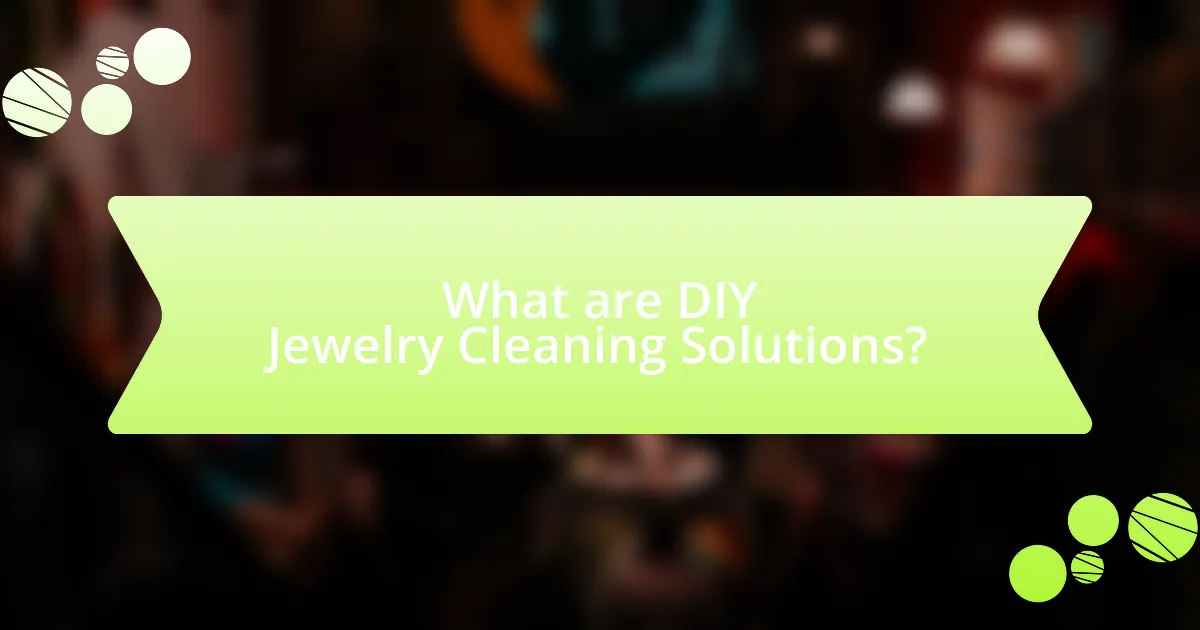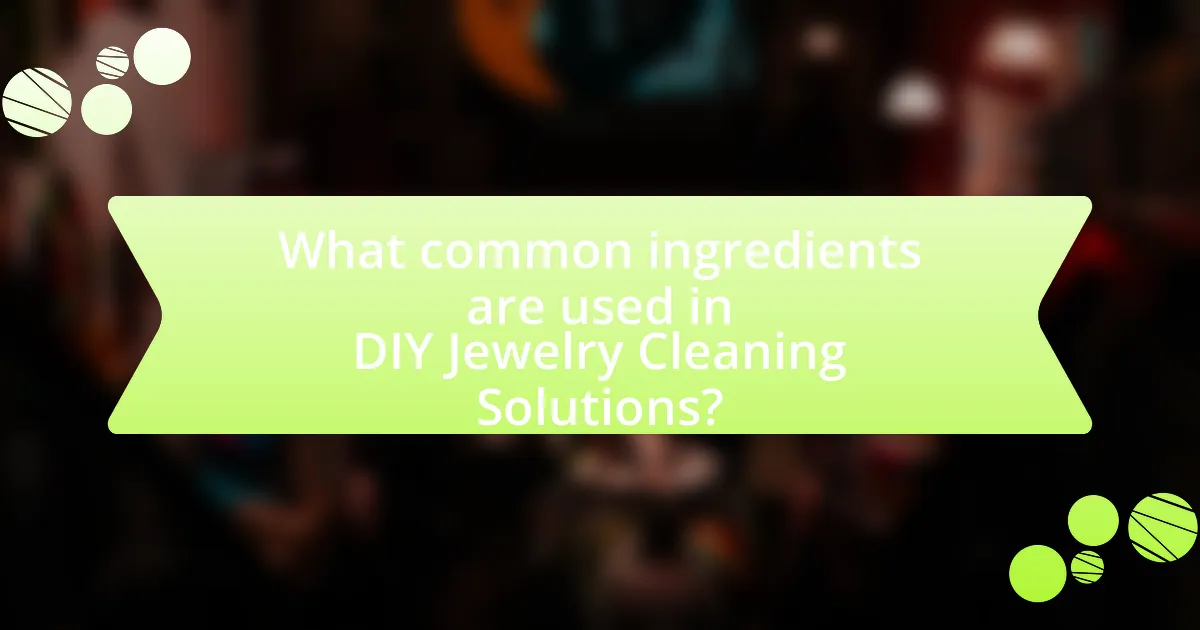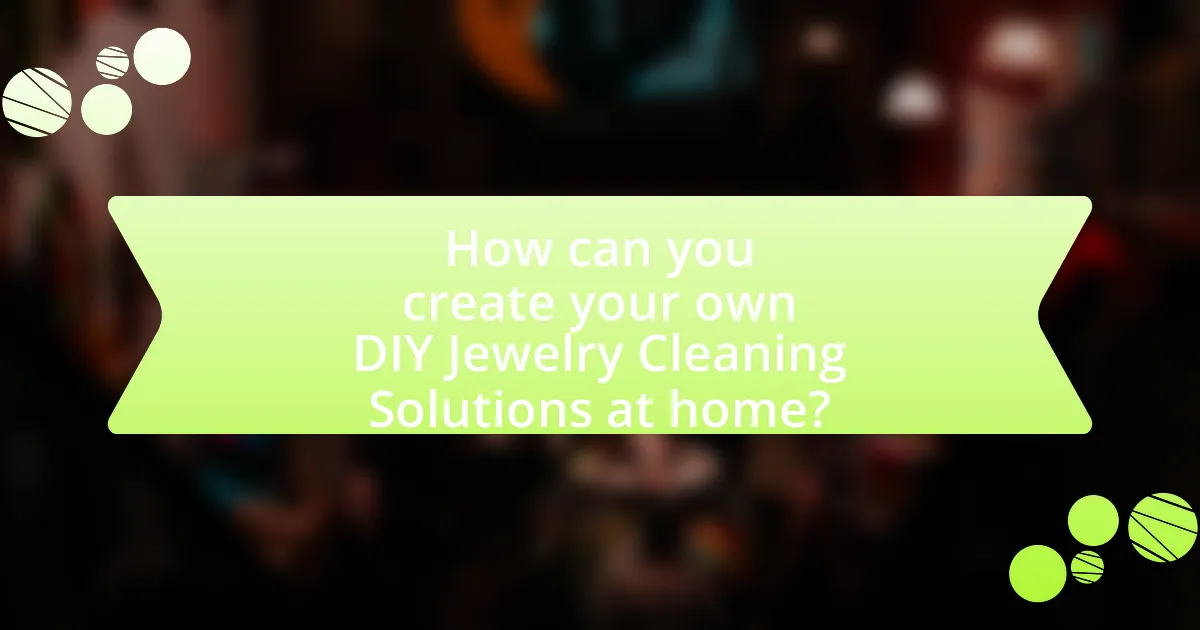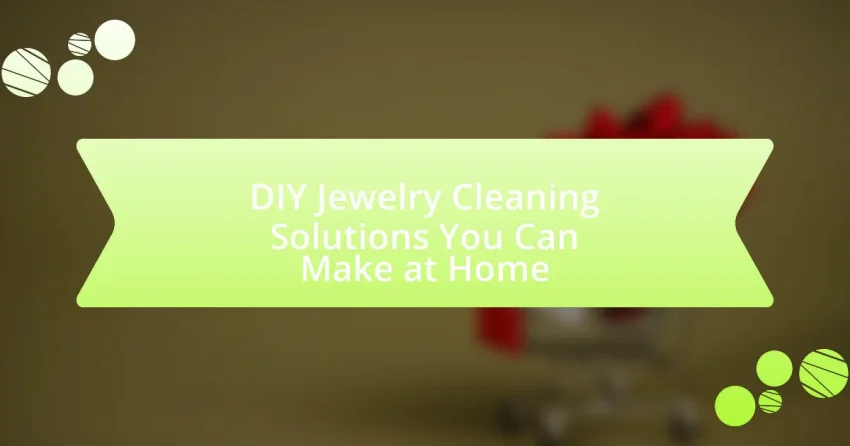DIY jewelry cleaning solutions are homemade mixtures designed to clean and restore the shine of various types of jewelry using common household ingredients such as baking soda, vinegar, lemon juice, and dish soap. These solutions are often more cost-effective and environmentally friendly compared to commercial products, although they may not be as effective for heavy tarnish. The article explores the advantages and disadvantages of DIY methods, the types of jewelry that can benefit from these solutions, and provides simple recipes and tips for effective cleaning. Additionally, it highlights the importance of using appropriate cleaning techniques for different materials to maintain the integrity of the jewelry.

What are DIY Jewelry Cleaning Solutions?
DIY jewelry cleaning solutions are homemade mixtures used to clean and restore the shine of various types of jewelry. Common ingredients for these solutions include baking soda, vinegar, lemon juice, and dish soap, which effectively remove tarnish and dirt without damaging the jewelry. For instance, a mixture of equal parts water and vinegar can clean silver jewelry, while a paste of baking soda and water can effectively polish gold items. These solutions are cost-effective and environmentally friendly alternatives to commercial cleaners.
How do DIY Jewelry Cleaning Solutions compare to commercial products?
DIY jewelry cleaning solutions are often more cost-effective and environmentally friendly compared to commercial products. While DIY solutions typically use common household ingredients like vinegar, baking soda, or dish soap, commercial products often contain specialized chemicals designed for specific materials. Studies indicate that DIY methods can effectively clean jewelry, particularly for routine maintenance, but may not remove heavy tarnish or deep-set grime as effectively as some commercial cleaners. For instance, a study published in the Journal of Cleaner Production highlights that homemade solutions can reduce chemical waste and are less harmful to the environment, supporting the preference for DIY options among eco-conscious consumers.
What are the advantages of using DIY solutions?
DIY solutions offer cost-effectiveness, allowing individuals to save money by using readily available household items instead of purchasing commercial products. For example, a mixture of baking soda and water can effectively clean jewelry without the expense of specialized cleaners. Additionally, DIY solutions provide customization, enabling users to tailor cleaning methods to specific materials and preferences, ensuring optimal care for various types of jewelry. Furthermore, using DIY solutions promotes environmental sustainability by reducing reliance on chemical-laden products, as many homemade cleaners utilize natural ingredients. This approach not only minimizes chemical exposure but also decreases plastic waste associated with commercial packaging.
Are there any disadvantages to DIY cleaning methods?
DIY cleaning methods can have several disadvantages, including the potential for damage to jewelry and ineffective cleaning results. For instance, using harsh chemicals or incorrect solutions can lead to tarnishing or deterioration of materials, particularly for delicate items like silver or gemstones. Additionally, DIY methods may not eliminate all bacteria or grime, as professional cleaning solutions are often formulated to target specific contaminants effectively. Studies have shown that improper cleaning can lead to long-term damage, emphasizing the importance of using appropriate methods for different types of jewelry.
What types of jewelry can benefit from DIY cleaning solutions?
Jewelry made from gold, silver, and gemstones can benefit from DIY cleaning solutions. These materials are commonly found in various types of jewelry, such as rings, necklaces, and bracelets, and can accumulate dirt and tarnish over time. For instance, a simple mixture of warm water and mild dish soap can effectively clean gold and silver jewelry without causing damage. Additionally, a paste made from baking soda and water can safely remove tarnish from silver pieces. Gemstones, like diamonds and sapphires, can also be cleaned using a gentle soap solution, ensuring their brilliance is restored.
How do cleaning needs differ between various materials?
Cleaning needs differ significantly between various materials due to their unique properties and sensitivities. For instance, gold and platinum jewelry can typically withstand stronger cleaning solutions and methods, such as ultrasonic cleaners, without damage. In contrast, porous materials like pearls and opals require gentle cleaning with mild soap and water to avoid deterioration. Additionally, gemstones such as emeralds and turquoise are sensitive to harsh chemicals and should be cleaned with soft cloths and specific solutions designed for their care. This differentiation in cleaning methods is essential to maintain the integrity and appearance of the jewelry, as improper cleaning can lead to scratches, discoloration, or even structural damage.
What precautions should be taken for delicate pieces?
Delicate pieces require careful handling to prevent damage during cleaning. Use a soft, lint-free cloth to gently wipe the surface, avoiding abrasive materials that can scratch. Additionally, avoid submerging delicate items in cleaning solutions; instead, apply the solution with a cotton swab or soft brush to targeted areas. It is also essential to test any cleaning solution on a small, inconspicuous area first to ensure it does not cause discoloration or damage. These precautions help maintain the integrity and appearance of delicate jewelry.

What common ingredients are used in DIY Jewelry Cleaning Solutions?
Common ingredients used in DIY jewelry cleaning solutions include baking soda, white vinegar, dish soap, and lemon juice. Baking soda acts as a gentle abrasive that helps remove tarnish, while white vinegar is effective in dissolving mineral deposits and grime. Dish soap, when mixed with warm water, creates a mild cleaning solution that can safely clean various types of jewelry. Lemon juice contains citric acid, which can help brighten metals and remove stains. These ingredients are widely recognized for their effectiveness and safety in cleaning jewelry at home.
How do household items serve as effective cleaning agents?
Household items serve as effective cleaning agents due to their chemical properties that can break down dirt, grease, and stains. For example, vinegar contains acetic acid, which can dissolve mineral deposits and cut through grime, making it useful for cleaning jewelry. Baking soda acts as a mild abrasive and a natural deodorizer, effectively removing tarnish from metals when combined with water to form a paste. Additionally, dish soap, which contains surfactants, can lift oils and residues from surfaces, enhancing the cleaning process. These items are not only accessible but also environmentally friendly alternatives to commercial cleaners, providing effective solutions for maintaining jewelry cleanliness.
What is the role of baking soda in jewelry cleaning?
Baking soda acts as a gentle abrasive and a mild alkaline cleaner in jewelry cleaning. It effectively removes tarnish and dirt from metals like silver and gold without scratching the surface. The alkaline nature of baking soda helps to neutralize acids that can cause corrosion, while its fine particles provide a scrubbing action that lifts grime. This dual action makes baking soda a popular choice for DIY jewelry cleaning solutions, as it is both effective and safe for various types of jewelry.
How does vinegar contribute to cleaning effectiveness?
Vinegar contributes to cleaning effectiveness primarily due to its acetic acid content, which acts as a natural disinfectant and stain remover. The acetic acid in vinegar can dissolve mineral deposits, grease, and grime, making it effective for cleaning various surfaces, including jewelry. Studies have shown that vinegar can kill certain bacteria and viruses, enhancing its role as a cleaning agent. For instance, a study published in the Journal of Environmental Health found that vinegar can reduce the presence of pathogens on surfaces, supporting its use in cleaning applications.
What natural alternatives can be used for cleaning jewelry?
Natural alternatives for cleaning jewelry include a mixture of baking soda and water, white vinegar, and lemon juice. Baking soda acts as a gentle abrasive that can remove tarnish and dirt without scratching the jewelry. White vinegar, when combined with baking soda, creates a fizzing reaction that helps lift grime, while lemon juice’s acidity can effectively break down tarnish on metals. These methods are widely recognized for their effectiveness and safety, making them suitable for various types of jewelry, including silver and gold.
How does lemon juice work as a cleaning solution?
Lemon juice works as a cleaning solution due to its high acidity, which effectively breaks down dirt, grease, and mineral deposits. The citric acid in lemon juice acts as a natural disinfectant, killing bacteria and removing stains. Additionally, lemon juice contains natural enzymes that help to dissolve tarnish on metals, making it particularly useful for cleaning jewelry. Studies have shown that citric acid can effectively remove calcium carbonate, a common mineral buildup, which supports its efficacy as a cleaning agent.
What are the benefits of using essential oils in cleaning solutions?
Essential oils provide multiple benefits when used in cleaning solutions, including natural antibacterial properties, pleasant fragrances, and non-toxic alternatives to synthetic chemicals. The antibacterial properties of essential oils, such as tea tree and lavender, have been shown to effectively kill bacteria and fungi, making them suitable for disinfecting surfaces. Additionally, essential oils like lemon and eucalyptus impart a fresh scent, enhancing the cleaning experience without the harsh odors associated with conventional cleaners. Furthermore, using essential oils reduces exposure to harmful chemicals, promoting a healthier environment, as many essential oils are biodegradable and derived from natural sources.

How can you create your own DIY Jewelry Cleaning Solutions at home?
To create your own DIY jewelry cleaning solutions at home, mix equal parts of water and white vinegar in a bowl for a simple solution. This mixture effectively removes tarnish from silver jewelry due to the acetic acid in vinegar, which reacts with the tarnish to dissolve it. Additionally, for a more abrasive cleaner, combine baking soda with water to form a paste, which can be applied to jewelry to scrub away dirt and grime. Baking soda is a mild abrasive that safely cleans without scratching most metals.
What are some simple recipes for effective cleaning solutions?
Simple recipes for effective cleaning solutions include a mixture of equal parts water and white vinegar, which effectively removes tarnish from jewelry. Another recipe involves combining two tablespoons of baking soda with a cup of water to create a paste that can clean metal surfaces. Additionally, a solution of warm water and a few drops of dish soap can be used to soak jewelry for a gentle clean. These mixtures utilize common household ingredients known for their cleaning properties, making them both accessible and effective for maintaining jewelry.
How do you make a baking soda paste for cleaning?
To make a baking soda paste for cleaning, combine three parts baking soda with one part water. This mixture creates a thick paste that effectively cleans various surfaces, including jewelry. The alkaline nature of baking soda helps to break down grime and tarnish, making it a popular choice for cleaning delicate items.
What is the process for creating a vinegar soak?
To create a vinegar soak, combine equal parts of white vinegar and water in a bowl. This solution effectively cleans jewelry by utilizing the acetic acid in vinegar, which helps dissolve tarnish and grime. Soaking the jewelry in this mixture for 10 to 15 minutes allows the solution to penetrate and loosen dirt. After soaking, gently scrub the jewelry with a soft brush to remove any remaining residue, then rinse thoroughly with water and dry with a soft cloth.
What tools and materials do you need for DIY jewelry cleaning?
To clean jewelry at home, you need a few essential tools and materials: a soft-bristle toothbrush, mild dish soap, warm water, a bowl, and a microfiber cloth. The soft-bristle toothbrush effectively removes dirt and grime without scratching delicate surfaces. Mild dish soap mixed with warm water creates a gentle cleaning solution that is safe for most types of jewelry. A bowl is necessary for soaking the jewelry, and the microfiber cloth is ideal for drying and polishing the pieces after cleaning. These items are commonly recommended by jewelers for effective DIY jewelry cleaning.
What types of brushes are best for cleaning jewelry?
Soft-bristle brushes are best for cleaning jewelry. These brushes, such as toothbrushes with soft bristles or specialized jewelry cleaning brushes, effectively remove dirt and grime without scratching delicate surfaces. The gentle bristles allow for thorough cleaning of intricate designs and settings, ensuring that gemstones and metals remain undamaged.
How important is the choice of cloth in the cleaning process?
The choice of cloth in the cleaning process is crucial for effectively maintaining jewelry. Different fabrics can either enhance or damage the surface of various materials, such as gold, silver, or gemstones. For instance, microfiber cloths are recommended because they are soft and non-abrasive, preventing scratches while effectively lifting dirt and oils. In contrast, rough fabrics can cause micro-scratches, diminishing the jewelry’s appearance over time. Therefore, selecting the appropriate cloth directly impacts the cleaning efficacy and longevity of the jewelry.
What tips should you follow for effective DIY jewelry cleaning?
To effectively clean jewelry at home, use a mixture of warm water and mild dish soap. Soak the jewelry for 15-20 minutes, then gently scrub with a soft toothbrush to remove dirt and grime. Rinse thoroughly under running water and dry with a soft cloth. This method is effective because mild dish soap is non-abrasive and safe for most materials, ensuring that the jewelry is cleaned without damage.
How can you ensure the safety of your jewelry during cleaning?
To ensure the safety of your jewelry during cleaning, always use a gentle cleaning solution appropriate for the specific type of jewelry. For example, a mixture of warm water and mild dish soap is safe for most metals and gemstones. Additionally, avoid using abrasive materials or harsh chemicals, as these can damage the jewelry’s surface or settings. It is also crucial to test any cleaning solution on a small, inconspicuous area first to check for adverse reactions. Following these guidelines helps maintain the integrity and appearance of your jewelry while cleaning.
What are common mistakes to avoid when cleaning jewelry at home?
Common mistakes to avoid when cleaning jewelry at home include using harsh chemicals, which can damage the metal and stones. Many individuals mistakenly apply bleach or ammonia-based cleaners, leading to discoloration or deterioration of the jewelry. Additionally, scrubbing jewelry too aggressively can scratch surfaces, particularly on softer gemstones like opals or pearls. Another frequent error is neglecting to rinse thoroughly after cleaning, which can leave residue that dulls the shine. Lastly, failing to dry jewelry properly can lead to tarnishing, especially in pieces made of silver.
